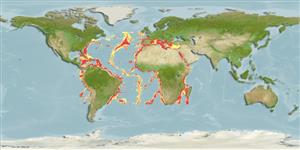Common names from other countries
Classification / Names / Names
ชื่อสามัญ | ชื่อพ้อง | Catalog of Fishes (gen., sp.) | ITIS | CoL | WoRMS
Environment: milieu / climate zone / depth range / distribution range
นิเวศวิทยา
กลุ่มสัตว์หน้าดิน,กลุ่มสัตว์พื้นท้องน้ำ; ระดับความลึก 200 - 3000 m (Ref. 1695). Tropical; 52°N - 35°S, 85°W - 46°E (Ref. 106956)
Atlantic, Mediterranean, Western Indian Ocean and the Pacific.
Length at first maturity / ขนาด / น้ำหนัก / Age
Maturity: Lm ? range ? - ? cm Max length : 2.5 cm ML เพศผู้/กระเทย; (Ref. 1695)
Mesopelagic or benthopelagic, but also found on the bottom at depth range to 1588 m, paralarvae found in mesopelagic and bathypelagic zones, far from coasts, with bottom depth ranging between 1,500 and 3,000 m. Adults live in groups in lower epipelagic and mesopelagic zones, common at depths between 200 and 300 m. Often found in areas inhabited by populations of red shrimps. Represents a sizeable component of the diet of several top predators, including dolphins, sharks, swordfish and tunas. Caught by pelagic nets and shrimp trawlers but of no commercial interest due to the low quantities available to fisheries (Ref. 1695).
Life cycle and mating behavior
วัยเจริญพันธุ์ | การสืบพันธุ์ | การวางไข่ | เซลสืบพันธ์ของเพศเมีย(ไข่) | ความดกของไข่ | ตัวอ่อน
Members of the class Cephalopoda are gonochoric. Male and female adults usually die shortly after spawning and brooding, respectively. Mating behavior: Males perform various displays to attract potential females for copulation. During copulation, male grasp the female and inserts the hectocotylus into the female's mantle cavity where fertilization usually occurs. Life cycle: Embryos hatch into planktonic stage and live for some time before they grow larger and take up a benthic existence as adults.
Jereb, P. and C.F.E. Roper (eds.). 2005. (Ref. 1695)
IUCN Red List Status (Ref. 130435)
CITES status (Ref. 108899)
Not Evaluated
Not Evaluated
Human uses
| FishSource |
เครื่องมือ
ข้อมูลเพิ่มเติม
Age/SizeการเจริญเติบโตLength-weightLength-lengthสัณฐานวิทยาตัวอ่อนอุดมสมบรูณ์
แหล่งที่มาจากอินเตอร์เน็ต
Estimates based on models
Preferred temperature
(Ref.
115969): 3.7 - 14, mean 7.1 (based on 746 cells).
Vulnerability
Low vulnerability (10 of 100).
Price category
Unknown.
